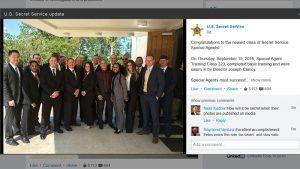The Situation Report: The Not-So-Secret Secret Service & Commercial Intelligence

The Not-So-Secret Secret Service (NSSS)
There’s something about the name of the U.S. Secret Service that has me wondering about the following imagery intelligence recently intercepted by my LinkedIn sensor network.
Special Agent Training Class 323 completed basic training and were sworn in by Secret Service Director Joseph Clancy on Thursday, Sept. 15, 2016. And if you’re curious, here’s a photo the agency released of all of the agents without their standard-issue Ray-Bans.

Private Intelligence Firms
If you want to know what whiz-bang technologies the CIA is researching and investing in, just look at the advertising technology industry. According to Chris Darby, president and CEO of the CIA’s venture capital firm, In-Q-Tel, ad-tech firms are generating identity intelligence in real time and at a granular level that many in the intelligence community are barred from collecting.
“These companies are intelligence agencies on their own,” said Darby, speaking Tuesday at the Third Ethos and Profession of Intelligence Conference in Washington, D.C.
“We’re trying to take the best technologies that are being deployed to these commercial entities and transfer it into the [intelligence] community. And they’re really good at it. They understand the notion of big data, they understand deep learning, and the algorithms that are necessary to pinpoint behavior,” he said. “To me, it’s almost a negative. What keeps me up at night is the notion that the commercial sector is going to be shaping individuals or digital tribes on their own, for their own benefit.”
One of the new focus areas within the CIA’s new Directorate of Digital Innovation has its roots in this growing commercial intelligence market. Andrew Hallman, deputy director of Digital Innovation at the CIA, said the agency has stood up an “anticipatory intelligence unit” that leverages emerging capabilities in big data and computing power to help the agency’s analysts stay ahead of developing situations around the world.
“The old saw in the intelligence community is that the IC is great at secrets and terrible at mysteries,” said Chris Inglis, the former deputy director of the NSA. “In the future, there are going to be fewer and fewer secrets as physical phenomena and the spoken word have fewer places to hide as the senors and the analytic power essentially reveals all things almost concurrent with the execution of those things.”
Homomorphic Encryption
The Intelligence Advanced Research Projects Activity, known as IARPA, is investing in research into homomorphic encryption—a potential game-changer in the worlds of privacy and security that enables encrypted queries of encrypted databases. Why would you want to do that? Well, it allows you to search sensitive or classified databases without decrypting either the database or the query.
“The goal of that effort is to balance the privacy and security interests in a way that allows for lawful queries against a database,” said IARPA Director Jason Matheny, who spoke Tuesday at the Third Ethos and Profession of Intelligence Conference in Washington, D.C. “For instance, if [the National Counterterrorism Center] was looking for a particular individual on a TSA list of passengers on an airplane, can we query for a match on just that individual’s name without giving up the entire list of all passengers? This also has applications in electronic health records and a range of other domains in which there has to be a balance of privacy and security.”
Synthetic Biology
But what really keeps Jason Matheny up at night? You guessed it—synthetic biology. My listening post stationed near George Washington University detected signals this week that Matheny is concerned about “advances in biology that either due to accident or intentional misuse could create pandemics that are worse than those of natural varieties.”
Matheny knows a thing or two about the topic, having once worked at the Center for Biosecurity at Princeton University. According to Matheny, scientists created the first synthetic virus from scratch about 14 years ago. “Our capabilities have gotten a lot more advanced since then and we’re racing to catch up with the security implications.”
